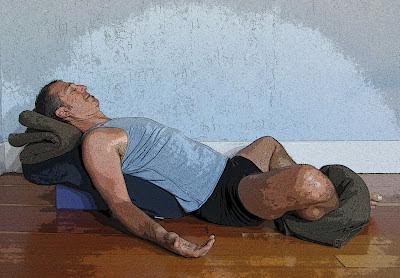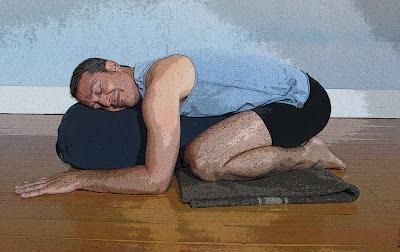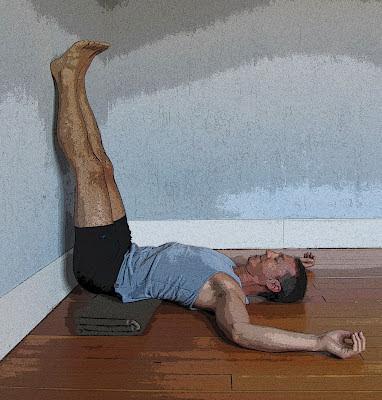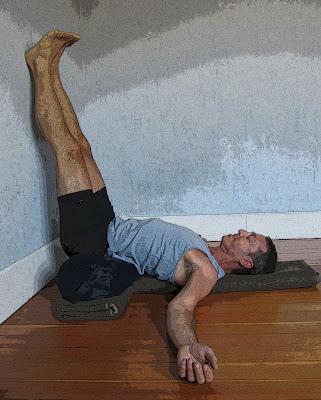Even though we posted this sequence a few years back, the day before American Thanksgiving seems like a good time to revisit Baxter's Mini Digestion Practice. Even if you don't celebrate American Thanksgiving—or if you don't overeat on that day—sooner or later we all need to pamper our digestive systems a bit.
A simple underlying principle for working with digestive issues is that no matter what’s going on, all digestive issues respond to restorative poses. Remember, the opposite of the Fight or Flight Response is the Rest and Digest Response (also known as the Relaxation Response—see Relaxation Reponse and Yoga for information). So, this mini restorative practice, which consists of three of Baxter’s favorite restorative poses, can be very helpful for digestive problems as well as other problems caused by stress, such as insomnia, fatigue, and anxiety.
1. Reclined Cobbler’s Pose, from 10 to 20 minutes. Set a timer so you don’t fall asleep in the pose.
One of the important parts of completing digestion is good elimination. In addition to physical relaxation, which this pose provides, gravity is also helpful for good elimination. As you can see from the photo, Reclined Cobbler’s pose creates a gradual slope from your head to your hips. Therefore, it’s possible that this pose can help with problems such as constipation and sluggish elimination. One of our favorite teachers, Patricia Walden, suggests that this pose may increase blood flow to your organs, as well as cool your digestive fire.
2. Supported Child’s Pose, for 3 to 5 minutes. Turn your head to the other side when you’re half way through.

As you can see from the photo, Child’s pose is a forward bend of your belly toward your thighs. Because the bolster is pressing against your belly, it’s possible this posture will have a stimulating effect on your digestive system and your abdominal organs. Patricia Walden suggests that this pose can relieve constipation, gas, and bloating.
3. Legs Up the Wall pose, from 10 to 15 minutes. Come out if your legs fall asleep.

This pose is a slight inversion (more so on the bolster than on the blanket). Therefore, it could have any even more profound quieting effect on your nervous system than the first two poses. Also because your hips are higher than your heart, there is a mild reversal of the effects of gravity, which could quiet an over-stimulated system in people who have, for example, IBS or chronic diarrhea. Patricia Walden says this is an excellent pose of nausea and diarrhea. However, if you have a history of gerd or chronic heartburn, take care with this pose, and come out if makes your symptoms worse.
Subscribe to Yoga for Healthy Aging by Email ° Follow Yoga for Healthy Aging on Facebook ° Join this site with Google Friend Connect
